
IRS Box Support
chrisf - 5/5/04 at 01:25 PM
Hi all. I'm looking for advice on how to support my IRS box. Usually, I suspect that verticle bending load are transfered to the shock towers.
However I'm using inboard damper.
I'm looking at two ideas. You can see in the pictures that the first idea is to weld 1/2 or 3/4" DOM from the corner of the IRS box to the
corner of what will be the chassis tower.
The second idea is to fabricate a large, fully-gusseted 'X' out of 1/2" or 3/4".065 DOM. The 'X' will the bolt to the
shock tower and the IRS box. If this will work, it may be a better solution as I can access the dampers easier.
Any thoughs are appeciated.
--Chris

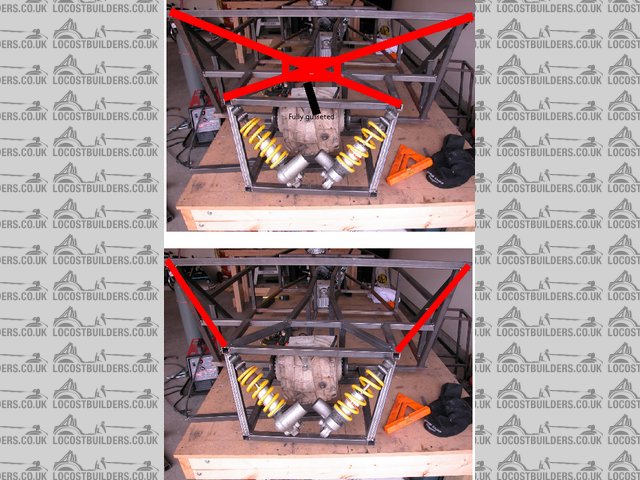
Rescued attachment SupportTogether.jpg
britishtrident - 5/5/04 at 01:40 PM
I don't think you have to involve the book shock towers at all, you should be able to transfer the loads to the chassis backbone and cockpit
side rails. and the key will be to triangulate the box as best a you can while leaving room for the drive shafts.
The chassis member below the diff where the shocks mount is going to take pretty massive loads also --- perhaps you could use a thick alloy or steel
plate bolted on to te back of the IRS box to stiffen
chrisf - 5/5/04 at 01:52 PM
lling a cross brace out of 6061. That way, it is removeable. I'll probably end up duplicating the supports on the top of the box.
pbura - 5/5/04 at 02:17 PM
How about mounting the shocks on a plate on top of the diff (after removing present top tubes)?
I would also X brace the bottom of the diff cage, run tubes from the rear four corners of the diff cage to the sides, and maybe have a bolt-on plate,
or bracing tubes, on the back of the diff cage.
phelpsa - 5/5/04 at 02:24 PM
I have been planning on doing what is in the second picture.
Adam
stephen_gusterson - 5/5/04 at 02:41 PM
Im no expert, but I would have thought the X version (first pic) would be subject to twisting due to the 'pivot point' formed by the
'x', even with the gusseting
atb
steve
[Edited on 5/5/04 by stephen_gusterson]
Mark Allanson - 5/5/04 at 06:10 PM
From a welders perspective (I'm not a designer), you cannot have triangulation without triangles.
The diff is going to try to transmit about 130ftlbs of torque into that frame so you have to channel it somewhere strong, I think you would also have
to beef up the lower rear panel to take the forces
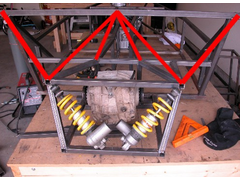

Rescued attachment Triangulation.jpg
Mark Allanson - 5/5/04 at 06:18 PM
or for even more power handling, connet up A and B to produce an immensly strong node at A

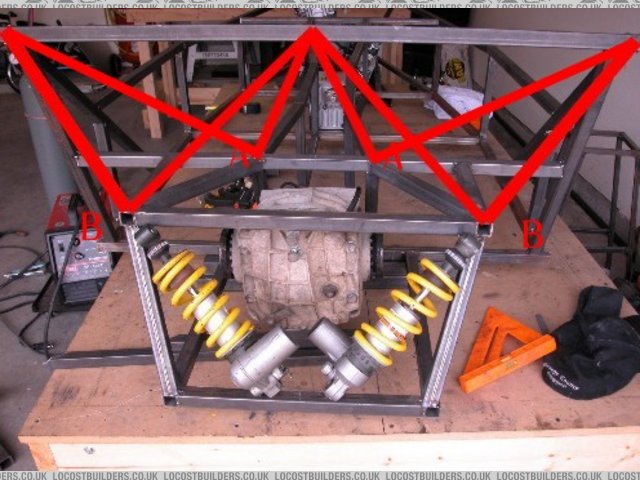
Rescued attachment Triangulation2.jpg
jcduroc - 5/5/04 at 10:29 PM
IMVHO forget the chassis tower.
1) Firstly think of where you're going to anchor your upper & lower wishbones.
2) Secondly consider a strong node for the attachement of your shocks. (Personally I wouldn't place them like that!)
3) Direct loads towards the tunnel and the chassis sides. (That straight ahead tube from the rear to the cockpit bulkhead - which I erased - does
nothing)
4) Excuse the s..tty drawing but I'm really a mess-up with PSP...
Cheers
Joćo


Rescued attachment Rrbay.gif
locost_bryan - 6/5/04 at 02:35 AM
I suspect you will need to triangulate, a bit like the Aussie mods around the front suspension. 
Don't know what arrangement you are using for the shocks (pushrod/rocker?), but would suggest moving the shockers inboard or outboard of the IRS
box to allow "proper" triangulation.
I assume the longitudinal tubes are for the wishbone pickups?
britishtrident - 6/5/04 at 06:00 AM
quote:
Originally posted by jcduroc
IMVHO forget the chassis tower.
1) Firstly think of where you're going to anchor your upper & lower wishbones.
2) Secondly consider a strong node for the attachement of your shocks. (Personally I wouldn't place them like that!)
3) Direct loads towards the tunnel and the chassis sides. (That straight ahead tube from the rear to the cockpit bulkhead - which I erased - does
nothing)
4) Excuse the s..tty drawing but I'm really a mess-up with PSP...
Cheers
Joćo
britishtrident - 6/5/04 at 06:11 AM
quote:
Originally posted by jcduroc
IMVHO forget the chassis tower.
1) Firstly think of where you're going to anchor your upper & lower wishbones.
2) Secondly consider a strong node for the attachement of your shocks. (Personally I wouldn't place them like that!)
3) Direct loads towards the tunnel and the chassis sides. (That straight ahead tube from the rear to the cockpit bulkhead - which I erased - does
nothing)
4) Excuse the s..tty drawing but I'm really a mess-up with PSP...
Cheers
Joćo
A 5 star explanation -- I think what some of the others are missing is that the forces with the largest magnatude have to be contained within the box
of tubes around the diff.
The shock towers are there because the book car needed them -- they are just cantilevered on to the core structure not particularly stiff.
As Joa spotted the damper reactions are going to a totally unsupported tube.
The other big forces are the the loads at the bell crank and the cornering+braking reactions at the lower wishbone pivots. Put enough triangulation in
the diff box with the nodes as close as possible to the spring-damper, bell crank and wishbone mounting points and the jobs done.
MikeRJ - 6/5/04 at 08:05 AM
I have simmilar style IRS construction on my chassis, although I'm not going to use inboard dampers. The structure that Joćo sumbitted, whilst
undoubtedly strong, looks a little impractical to me as the outer tubes running from the back of the differential "box" forwards to the
outside of the main chassis would prevent attaching the wishbones to the diff box. (unless I've missed something obvious).
stephen_gusterson - 6/5/04 at 09:26 AM
This is when some one should say that IRS doesnt provide huge increases in grip over a std live axle set up, is a lot harder to implement, and easy to
get crap geometry, cos suspension issues are a specialist minefiled.
So I have 
atb
steve
[Edited on 6/5/04 by stephen_gusterson]
Bob C - 6/5/04 at 09:32 AM
The shock towers is where the torsional stiffness of the book chassis all leads to - IRS with inboard shocks has to somehow connect this to the
"box", whilst allowing wishbones to move up & down and not breaking due to hitting potholes and allowing access so the diff can be
fitted/ removed and the fuel tank and leave some boot space (OTT I know) while not putting in a ton of metal. Tricky...
IRS with outboard shocks is much easier, suspension loads go where they're supposed to and there is zero vertical stress on the top bone
(precious little on the bottom one either) just "pothole" stresses to worry about. BTW diff torque countered easily by a diagonal in the
sides of the transmission tunnel + it's peanuts compared to suspension loads!
There must be builders who've completed their IRS systems with tales to tell - any photos of the much maligned avon or such? Anybody had any bits
bend in service??????
Cheers
Bob C
Peteff - 6/5/04 at 09:46 AM
Use a de dion, it's so much simpler and it's got to be lighter than all the scaffolding you are putting in there. What are the dampers you
have? The massive blob on the bottom looks like it will get in the way. The diff cage looks too wide, your top wishbones will be short and cause
problems. Don't cause yourself problems just to be different, try it the easy way first then get creative.
pbura - 6/5/04 at 12:16 PM
Chris,
If you were to remove the diff, which way would you go? Out the bottom or out the back?
I've also been wondering whether it would be possible to mount each shock vertically inside the top tube, and mounted to the bottom tube, just
behind the axle shaft.
chrisf - 6/5/04 at 01:29 PM
Hi all. Thanks for all the responses. Ive gotten quite a few good ideas. The first of which is that the X brace with gussets was a horrible idea. As
to the diff box, I should have stated that the box pictured was in an incomplete state. The R1 dampers are located there in the picture for idea
purposes. After hashing it out, I will mount the dampers to the top of the diff box. A bellcrank system will be used to activate the damper.
Basically, a big triangle will be used: one corner attached to the top of the damper, one to a pickup between the upper A arm and the other to the far
corner of the A arm, near the upright.
The diff box itself is very strong and rigid. There will be two braces from the lower trans tunnel to the lower corners of the diff box, and this will
help stiffen even more. Do this will make getting the diff in and out of the box more difficult, but doable. I will have to tilt the diff sideways and
shove it in from behind. I will fabricate a removable sheet of Ti or Ali for the rear of the box. This should stiffen things up quite a bit.
I could design a DeDion, but then again, I might as well use a live axle. Yes, I under stand their differences. But I chose to use an IRS. Once can
argue the merits of IRS:Live axle/DeDion, but as far as IRS goes, this is the best Ive seen. I just need to solve the box support problem.
Those big lumps on the bottom of the dampers are a remote reservoir. Penskes and such usually have a stainless braided tube that goes from the
reservoir to the damper; mine is attached. The dampers are double adjustable for bump and rebound.
Since this discussion started, Ive looked at a few IRS designs from builders such as Westfield and MK. Though perhaps not the ideal (I certainly like
the cars!), they get away with much less than the modifications suggested here. In the end, I may use some of the suggested modifications, but think
BobC may have distilled it the best, just a simple support to the tower!
--Chris
ned - 6/5/04 at 01:47 PM
remember to allow enough space for the fuel tank with any supports you're putting in for the dif cage. I was going to do something similar to
what you are trying,, but decided to go with a dedion axle in the end, £150 its a simple drop in option!
Ned.
Bob C - 6/5/04 at 02:37 PM
If you use bellcrank with dampers atop the box, going across, you will have the bellcrank hinge just where the top wishbone hinge is. So use that.
Alternatively make the top bone into a rocker & attatch the dampers to that, simpler and may stress more predictably - your call! Be interesting
to see your final solution!
Bob C
chrisf - 6/5/04 at 02:58 PM
Weve chatted on this topic offline before. My reasoning for a separate mount is for adjustability purposes. If I use rod ends, I can make small
changes to adjust the motion ratio, thus changing the spring/dampning rate. Im still trying to design the smaller details in my mind, and some of the
design depends of the upper rear wishbone designwhich is still being finalizedJ.
I wanted to finish fabricating the rear before I got on with the rear suspension, thus the original post.
crbrlfrost - 6/5/04 at 03:42 PM
I was just curious why people thinks the torsional loads should be fed to the shock towers. The primary torsional component to the chassis is the
transmission tunnel, not the side walls. Not to mention one of the shock tower tubes is placed in bending and the rear bulhead isn't exactly the
best triangulated structure. I think as well that the best way to impliment an IRS with inboard shocks is to attach directly to the rear tunnel as
well. I've sheeted mine in by bonding aluminium to three sides and triangulating as well as I could on the other two. Frankly, I wouldn't
trust the book shock towers under serious racing as the shocks can transmit some of the largest suspension loads of all.
stephen_gusterson - 6/5/04 at 03:47 PM
I fully welded 1.6mm plates, and added extra bracing in the 'quadrant' areas each side of the bulkhead, by your sholders.
In this case any loads into the towers woudnt cause the bulkhead to take the load - it would go straight into the chassis sides.
atb
steve
Bob C - 6/5/04 at 04:44 PM
Doh! chris - of course it's you - apologies for telling you your own ideas!!! What am I like. I very nearly suggested you got in touch with
yourself........
Cheers
Bob
Liam - 11/5/04 at 09:58 PM
Hello...
I'm doing irs and inboard all round too. Top rockers (rather than pushrods) I thought would be nice and easy to design/analyse. Well,
relatively.
Anyway here is a piccy of my balsa model that I made to do some practical stifness testing (FEA model may come soonish now that I think i've
acquired a 'naughty' copy of ANSYS), since it's easier to photograph than the real thing. I personally think it's a good idea to
link to the top corners of the rear bulkhead. If triangulated and/or panelled, this bulkhead is a stiff structure so it makes sense to feed loads
into the corners and down the chassis sides.
Of course, as has been said, the tunnel is a major player in the structure (and the diff mounts there too) so i'm feeding loads down there as
well. But remember this isn't reeeeally supposed to be just a backbone chassis (like a TVR) and the tunnel isn't very hefty (only 6"
wide and 3/4" 16swg RHS) so the tubes are gonna be insanely stressed if the tunnel is taking all the torsoinal loading. Makes sense to me to
feed loads out wide and down the sides too.
In my model the two tubes from the back of the diff box to the top corners of the rear bulkhead contribute a bo**ock load to the stiffness of the back
end. Essential for a decent irs design IMHO (especially if your shocks mount up there in the normal position - unlike mine or chrisf's). Also
remember the roll bar mounts there too so this should be a strong point.
Liam
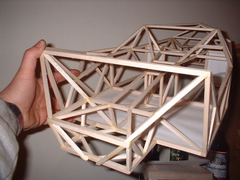

Rescued attachment chasismodel.jpg
Liam - 11/5/04 at 10:12 PM
Here's a piccy of how it's shaping up in the metal.
Main reason I'm doing it this way is to have the different mounting positions for the shocks. I'll have a range of about 80 - 130 cycles
per minute wheel frequency which should be fun playing around with. The idea is softish and comfyish on the road and hard for the track 
Top wishbones needs finishing and they will be triangulated structures themselves to take the large loads they're subjected too.
Liam
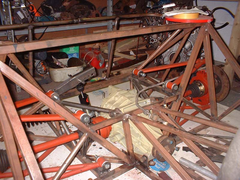

Rescued attachment rear.jpg
pbura - 11/5/04 at 10:17 PM
Very fine piece of work, Liam 
Where will the shocks go? And how about turning that baby around and giving us a show and tell on the front and the left side? 
Pete
Edit: My post crossed with your putting up your 2nd pic! 1st question answered, and I was hoping for something like that.
So, you just welded the rocker to the bush tube, apparently. Certainly nice and simple. Got any concerns about it holding up? Great-looking
wishbones, btw.
[Edited on 12/5/04 by pbura]
MikeRJ - 12/5/04 at 08:46 AM
quote:
Originally posted by pbura
So, you just welded the rocker to the bush tube, apparently. Certainly nice and simple. Got any concerns about it holding up?
That is a neat design. Should hopefully be plenty strong enough when the appropriate triangulation has been added.
ned - 12/5/04 at 09:06 AM
Sorry,
Hope this isn't a stupid question, but is there enough room to get the dif in and out, as on a lot of designs I've seen that are ultra stiff
you end up closing a gap that the dif might need if it were to be removed.
Ned.
James - 12/5/04 at 10:05 AM
quote:
Originally posted by ned
<snip>
is there enough room to get the dif in and out, as on a lot of designs I've seen that are ultra stiff you end up closing a gap that the dif might
need if it were to be removed.
Ned.
Who on earth would go and do a silly thing like that!  Doh!
Doh! 
The one thing that bothers me about some of these designs is the shear amount of metal in them!
If you look at pictures of how MK has done their IRS backend it's a lot lighter. At the same time I've not heard of anyone complaining that
the back end of their MK chassis has collapsed!
Not that I know anything about chassis design so I'm probably talking rubbish! 
Cheers,
James
spunky - 12/5/04 at 10:41 AM
I agree with you James,
I also no nothing about chassis design but there is a lot of steel in use in some of the chassis posted on this forum.
I worry when I look at my chassis and wonder if its up to the job, but it was designed and built by Stuart Taylor who has a fair racing pedigree.
I guess the "better safe than sorry" is particularly relevent in chassis building.
I really like Liams design of the rocker/wishbone assy. Got me thinking of future projects...
John
stephen_gusterson - 12/5/04 at 11:24 AM
I mounted my diff by using two 3mm plate arrangements - but then my IRS bones are not hanging off that point...........
atb
steve
chrisf - 12/5/04 at 12:56 PM
That was a cool box design. I have not welded my lower supports yet. I am concerned about being able to remove the diff as well.
Yes, the back of the car can acquire quite a bit of weight. But I'm planning to use other materials for the removable supports. Honestly, I
suspect the portly Sierra diff is cause of most of the weight. The steel I used for the 'box' so far pales in weight comparison to the
diff!
--Chris
pbura - 12/5/04 at 02:34 PM
There's some comfort in the fact that 20 feet of extra tube weighs only about 16 lbs. 

I got interested in IRS because it seems to be the cleanest way to do inboard shocks. For someone interested in a conventional shock layout,
Donkervoort has a very efficient design, much stronger-looking to me than the Tiger-style "box" and not a ton of metal:


IRS rear
Mave - 12/5/04 at 03:17 PM
Yep, the Donkervoort design is very good indeed. I modelled my design like that, (see http://www.mk-indy.nl/images/chassis%20assy.jpg) and had it FEA
analysed. It is VERY stiff. And pretty easy to make: aligning the brackets is easy. (well, it is easy when you know how to weld, which was my problem)
Mave - 12/5/04 at 03:20 PM
Oh, by the way: have you noticed where they place the fueltank? It is in the picture, look hard!
chrisf - 12/5/04 at 05:51 PM
Mavee
Great job on the IRS 'box' design. You wouldn't want to share those files, would you? I'd like specifically to see how you
designed the roll bar mounts, as well as study up on the diff box bracing.
--Chris
Liam - 12/5/04 at 09:00 PM
Hello...
Cheers for the positive comments dudes. I'm stupid, and almost that stupid, but not quite - the diff comes out of the top of the box. The room
behind the diff where the shocks go provides just enough space to get it out. Bit of a jiggle - but not as tight as the front diff
As for the weight, the triangulation is only 3/4" 16swg, and to vaguely quote someone else: lots of it weighs not much. My chassis has
something like 15-20 kg extra tubing in it compared to a book chassis, and that's including all the irs, my structural scuttle and my removable
bracing over the engine linking the scuttle to the front suspension. If I remember, that's roughly all offset by using aluminium panelling
instead of steel in the floor and such like. The chassis in these cars isn't very heavy and isn't really the place to save weight (unless
you're building an extreme BEC). It is the place to chase excellent stiffness imho and the benefits that gives.
No one's MK or whoever's chassis is gonna fall apart or anything, but that sort of thing has to be designed to be cheap, quick and easy to
produce to be viable for the seller, and still perform more than acceptably. People like me can spend ages chopping up tube in the quest for ultimate
stiffness (if they think that's important).
I really like the donkervoort rear end, but am surprised it seems to have no tunnel at all. Oh well. Dax rush irs chassis is nice too. Mave your
design looks cool - in fact your rear bulkhead looks almost identical to mine. Great minds eh . I'd really like to get mine FEA'd to see
if it's all been worth it. I doubtless have a few tubes sitting there doing nothing, but hopefully dont have any glaring weaknesses that ruin
all the good parts. Hopefully will get some FEA software before I just go ahead and paint the chassis!
. I'd really like to get mine FEA'd to see
if it's all been worth it. I doubtless have a few tubes sitting there doing nothing, but hopefully dont have any glaring weaknesses that ruin
all the good parts. Hopefully will get some FEA software before I just go ahead and paint the chassis!
Oh yeah - my wishbones as they are are definately not up to the job! In my softest setting my suspension leverage is 2.5 to one so
there's some big load on the rocker and it's pivot. The wishbones are still to receive a tube from the other bush to the inner end of the
rocker for fore/aft location, and the most important tube from outer balljoint (where the upright connects) also to the inner end of the rocker, to
eliminate bending.
The pivot point is quite heavily loaded (about 500kg upwards when the car is just sitting there in the softest setting) and the rearmost bracket which
is almost in line with the inner and outer ends of the wisbone takes most of the load. The bracket there is doubled up to 6mm thick and I'll use
decent M12 shoulder bolts. All plenty strong enough - but it did surprise me a bit when I calculated the load on the pivot. It's the high
leverage on my soft setting that does it - something to bear in mind if you're doing a similar design.
Time to shut up...
Liam
MikeRJ - 12/5/04 at 09:30 PM
quote:
Originally posted by Liam
The pivot point is quite heavily loaded (about 500kg upwards when the car is just sitting there in the softest setting)
The only thing that would worry me would be the ability of a poly bush to take those kinds of loads for any length of time.
The Donkervoort design is very nice, gives loads more storage room as well. Shame there isn't any McSorely type plans for something like this.
[Edit] talking nutsack again.
[Edited on 12/5/04 by MikeRJ]
Liam - 12/5/04 at 09:59 PM
Yeah that's my only concern really. I think they ought to be abe to take it (i'm not exactly the first person to try this), but I'll
be keeping an eye on the bushes. I may eventually upgrade them to proper bearings if they're not up to the job.
LIam
Mave - 13/5/04 at 04:54 PM
Why need a McSorely-plan when you can have a Mave-plan? (well, sort of; I'll not make all those tube drawings like McSorely).
If anyone is interested, drop me a mail, and I'll send you a 2,7 Mb 3D file you can look at, turn around, etc.etc.
Ah, let me see if I can attach it to this message....
chrisf - 22/8/04 at 08:01 PM
Hi All:
Many thanks to everyone who helped guide me many months ago. I've finished the final design and just have some minor revisions to some little
things.
Concerning the original post, this is what I came up with. On the bottom of the diff box, I'll use the 5mm 6061 or 1.5mm Ti. i realize the upper
arm angle looks a bit concerning. I hope that the chassis will settle to ride height as the weight builds. I also need to adjust the spring preload.
Of course, if all else fails, some Eibach spings may be in the cards. But that is a different post! Again, thanks for all the help.
--Chris
[Edited on 22/8/04 by chrisf]
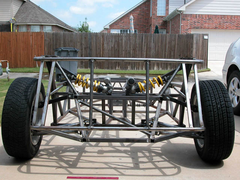

Rescued attachment RearSuspension1Small.jpg






















